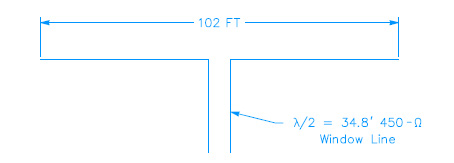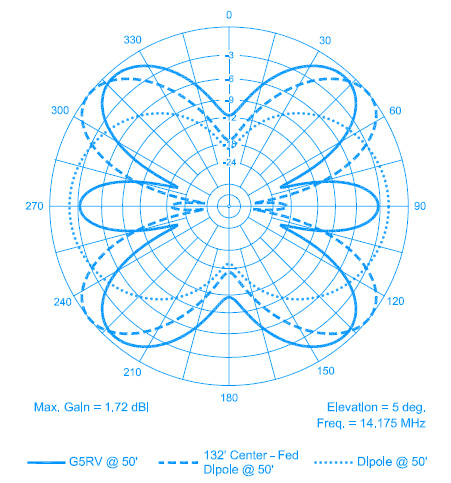Designed in England by Louis Varney (G5RV) some years ago, it has become quite popular in the US. The G5RV design is shown in Fig 8. The antenna may be used from 3.5 through 30 MHz. Although some amateurs claim it may be fed directly with 50-Ω coax on several amateur bands with a low SWR, Varney himself recommended the use of an antenna tuner on bands other than 14 MHz. In fact, an analysis of the G5RV feed-point impedance shows there is no length of balanced line of any characteristic impedance that will transform the terminal impedance to the 50 to 75-Ω range on all bands. (Low SWR indication with coax feed and no matching network on bands other than 14 MHz may indicate excessive losses in the coaxial line.)
Fig 2 shows the 20-meter azimuthal pattern for a G5RV at a height of 50 feet over fl at ground, at an elevation angle of 5° that is suitable for DX work. For comparison, the response for two other antennas is also shown in Fig 2—a standard half wave 20-meter dipole at 50 feet and a 132-foot long center-fed dipole at 50 feet.
The G5RV on 20 meters is, of course, longer than a standard half wave dipole and it exhibits about 2 dB more gain compared to that dipole. With four lobes making it look rather like a four-leaf clover, the azimuth pattern is more omni directional than the two-lobed dipole. The 132-foot center-fed dipole is longer than the G5RV and it has about 0.5 dB more gain than the G5RV, also exhibiting four major lobes, along with two strong minor lobes in the plane of the wire. Overall, the azimuthal response for the G5RV is more omni directional than the comparison antennas.
The G5RV patterns for other frequencies are similar to those shown for the 135-foot dipole previously for other frequencies. Incidentally, you may be wondering why a 132-foot dipole is shown in Fig 2, rather than the 135-foot dipole described earlier.
The portion of the G5RV antenna shown as horizontal in Fig 1 may also be installed in an inverted-V dipole arrangement, subject to the same loss of peak gain mentioned above for the 135-foot dipole. Or instead, up to 1⁄6 of the total length of the antenna at each end may be dropped vertically, semi-vertically, or bent at a convenient angle to the main axis of the antenna, to cut down on the requirements for real estate.
 |
| Fig. 1 |
 |
| Fig. 2 |
Source: ARRL Antenna Handbook 2010

No comments:
Post a Comment